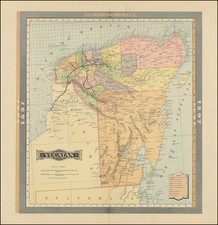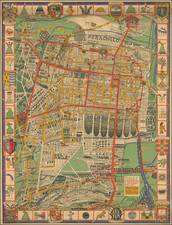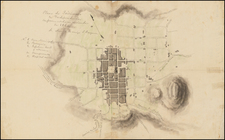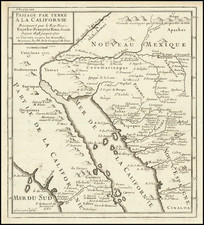Foundational Mexican Iconography
Finely executed early 19th-century manuscript and watercolor copy of the first page of Codex Mendoza, an iconic pictograph which represents the foundation of Tenochtitlan. This beautiful hand-colored rendition was made by William H. Shippard, an intriguing figure in early Mesoamerican studies who was active in Britain during the 1830s and 1840s.
The Codex Mendoza is an Aztec codex, believed to have been created around the year 1541.
Iconic Eagle and Cactus: Foundational Myth of Aztecs
The first page of the Codex Mendoza presents a visually striking image that captures a foundational myth of the Aztec Empire. At the center, an eagle perches majestically atop a nopal cactus, its wings spread wide, and its beak open as if in mid-call. This eagle holds a snake in its talons, symbolizing the triumph of good over evil. Below the cactus, a series of glyphs and symbols detail the Aztec journey to Tenochtitlán, the site where this scene unfolds, marking the divine mandate for the Aztecs to establish their capital there. The image is framed by water, indicating the island nature of Tenochtitlán. Around the central figure, the codex intricately illustrates the Aztec’s complex social, political, and religious beliefs, encoded in a series of glyphs and pictograms that narrate their history and cosmology. The use of vibrant colors and detailed iconography in this codex embodies the rich artistic and cultural legacy of the Aztec civilization.
Codex Mendoza
Among the most important of Mexican codices, the Codex Mendoza is a 16th-century Aztec document created around 1541. It is an informative compilation detailing the lineage of Aztec rulers and their conquests, alongside insights into the everyday life of the Aztecs before Spanish conquest. Written in Aztec pictograms, it also includes Spanish translations and annotations. The document is named after the first viceroy of New Spain, Don Antonio de Mendoza, who oversaw its creation and was a significant patron of indigenous artistry.
Now housed at the Bodleian Library in England, the Codex Mendoza details the establishment of Tenochtitlan. It is a screen-fold book made of bark paper and uses the Aztec script, with dimensions of 140 by 23.5 cm. Mendoza commissioned this document, recognizing the loss of Indigenous artifacts and traditions following the Spanish conquest. He organized a workshop where native artists and scribes, under Spanish ecclesiastical guidance, could replicate these works.
The document, also known as the Codex Mendocino and La Colección Mendoza, has been part of the Bodleian Library since 1659 and was featured in an exhibition there in 2023. The Bodleian holds several other Mesoamerican manuscripts.
The codex's production likely took place between 1529 and 1553. The manuscript's hurried completion is noted on its final page, which apologizes for the unrefined interpretation of the pictograms due to time constraints. Controversy surrounds the precise dating and purpose of the manuscript, with various historical accounts contributing to the debate.
This important codex, largely unnoticed until rediscovered in the 19th century, serves as a key historical source for understanding Aztec civilization and the early period of Spanish rule in the New World.
Shippard's handwritten note comprises a summary description of the pictographs and their significance, along with a fascinating overview of the Codex Medoza's history:
Facsimile of Page 1 of the Mendoza Collection of Mexican Picture paintings preserved in the Selden MS at the Bodleian Library, Oxford. [?] Arch. Seld. A. 1 Cat. MSS. Angl. 3134 - in 73 pages. This Painting represents the founding of the City of Mexico on a marshy spot [surrounded?] by canals dug in the form of a St. Andrews Cross, the centre showing a [cactus?] where Eagles used formerly to alight and devour their prey; also giving the 10 Lords of Mexico at first with the several symbols of their names attached to them, and specifying the one chosen for King. The [margins?] offering Astronomical signs of the number of years. 11 & 12 conquering 2 other cities.
The Spanish governor of Mexico obtained these Paintings from the Indians and sent them to the Emperor Charles V. The Ship in which they were forwarded was captured by a French Man of War. Andrew Thevet (whose signature is affixed) (Astronomer to Queen Catherine de Medicis and Historiographer & Geographer to the King of France then obtained them after Thevet's death. Hackluyt bought them and procured Mr. Michael Locke in Sir Walter Raleigh's name to translate them at Sir W Raleigh's death he left them to Purchas from whom Spelman afterwards had them from whom it is supposed Selden procured them.
W. H. Shippard, Charles Fort, Kinsale 16 Oct. 1834
William Henry Shippard's Mexican Paintings
William H. Shippard (1803-1865) was a pioneering 19th-century British museologist - an unsung progenitor of modern-day museum anthropology. While he is chiefly remembered as a friend of George Catlin, Shippard's profound interest in the ancient civilizations of Mexico connects him with a cohort of British contemporaries that include Lord Kingsborough and the showman William Bullock. Shippard's fascination with Mesoamerica propelled him to amass a significant collection of visual material derived from Aztec codices which he copied himself. A figure of some intrigue and scholarly ambition, Shippard endeavored to establish the Museum of Mankind in London, which seems to have evolved from his deep interest in early Mexican cultures. Although the museum did not come to fruition, Shippard's original artwork, mainly pen and ink drawings enriched with vibrant hand coloring, based on Mexican codices held in European libraries and collections, remains a valuable historical source, particularly for understanding the allure of Mexican antiquity within early 19th-century British collecting circles.
Capt. William H. Shippard, a friend of George Catlin and an avid watercolorist and museologist, was also a pioneering British Mesoamericanist. Shippard appears in British newspaper notices from the 1840s as a London-based lecturer who spoke about Native Americans and Mexican antiquities. We know he was a friend of George Catlin, and that he was involved in attempts to organize early London museum exhibitions of Mexican antiquities. In the latter efforts Shippard would seem to coincide with a group of like minded prominent English collectors interested in Mexican topics active during the 1820s and 1830s, including Lord Kingsborough and the bibliomaniac Sir Thomas Phillipps, among others. He seems to have been an armchair anthropologist and would-be museum founder, whose ambitious ideas for a London-based museum never got off the ground - at least not beyond the prospectus-printing stage. Certain aspects of Shippard's career are akin to William Bullock, the showman and connoisseur of Mexican antiquities who actually did travel to Mexico. Bullock published a notable book about his Mexican travels, and achieved a level of recognition in his day as the empresario of London's Egyptian Hall, wherein he thrilled large London audiences with his elaborate exhibitions of exotica, including Mexican items.









![[ Mexico ] [Painted map of Mexico and the Southern United States by a Noted Artist who studied mural painting under David Siqueiros]](https://storage.googleapis.com/raremaps/img/small/101948.jpg)

![Die Einwohner in Magellanica [The Inhabitants of Magellanica]](https://storage.googleapis.com/raremaps/img/small/94088.jpg)


